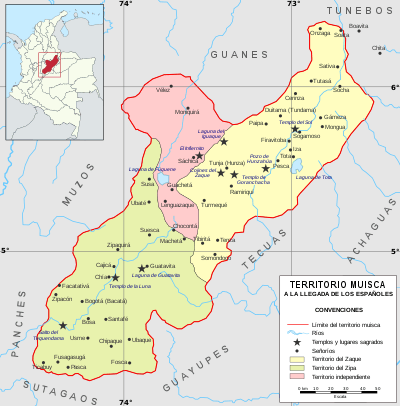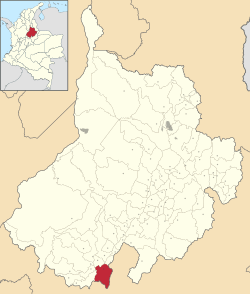Puente Nacional, Santander
Puente Nacional (Spanish pronunciation: [ˈpwente nasjoˈnal]) is a town and municipality in the Saravita Valley, part of the Santander Department of northeastern Colombia.

Puente Nacional, Santander | |
|---|---|
Municipality and town | |
 Flag | |
 Location of the municipality and town of Puente Nacional, Santander in the Santander Department of Colombia. | |
| Country | |
| Department | Santander Department |
| Founded | 1556[1] |
| Founded by | Andrés Díaz Venero de Leiva[1] |
| Area | |
| • Total | 315 km2 (122 sq mi) |
| Elevation | 1,625 m (5,331 ft) |
| Population (Census 2018[3]) | |
| • Total | 12,586 |
| • Density | 40/km2 (100/sq mi) |
| Demonym(s) | Pontanalino -a |
| Time zone | UTC-5 (Colombia Standard Time) |
| Website | www.puentenacional-santander.gov.co |
The area was originally inhabited by four Muisca tribes[4][5], three of which named the: Semisos, Irobaes y Popobas, their heritage now only surviving in the names of three surrounding veredas.
The area between Puente and neighbouring Santa Sofía (or Guatoque) was inhabited by a major tribe called the Sorocotá [6], governing a major commercial centre possibly home to the region's largest agricultural market.[7][8][9]
Puente's local radio station is today called La Voz de Sorocotá (The Voice of Sorocotá).
The town still has a market every Monday which sees locally sourced produce brought to the town from the town's plethora of surrounding farms.
The Hoyo de La Romera on the side of Santa Sofía remains the only alleged historical vestige to the area's indigenous past, though the claim is yet to be supported by archeological evidence.[12]
Gonzalo Jiménez de Quesada travelled south through the area in 1537 [13][14][15] in the search for El Dorado.[16] Having followed the course of the Magdalena River[17], his expedition then travelled down the Saravita, which formed the main trajectory of the subsequent conquests. It was in this area that some sources report that Quesada's men made the first ever encounter with a "truffle" crop later identified as the potato. [18][19][20]
Following the Spanish conquests a new town was baptised Puente Real de Vélez, existing as a subsidiary to the town founded by Martin Galeano in 1539,[21] before eventually acquiring its current name during the period which followed the comunero rebellions of 1781.[22]
These local uprisings set in motion the first wave of Spanish American victories against the Spanish Empire, however an eventual liberation only arrived after 1819.
Every year on the 8th of May week, the town transforms with homage to the comuneros. On the day of the main celebration, townspeople dress in traditional late-18th century attire and have parades across the town.
The town's Cantarrana Street was the setting for a now-regularly commemorated massacre at the close of the bipartisan Colombian Civil War of the mid-twentieth. [23] On 29 September 1960, the decennial conflict antagonising liberals and conservatives culminated with a shooting involving local brigand Efrain Gonzalez killing 11 civilians and injuring 19.
In nearby Florían lie the Windows of Tisquizoque[24] waterfalls, associated with the former cacique of the same name.
Furthermore, interest in El Peñon has also risen prominently because of speleological research[25] and tourism.
The town has a tropical climate with significant precipitations even during the driest month.[26] The area's average monthly temperatures range the mid 20s [27][28].
References
- "Puente Nacional (Puente Real): Cuna de la guabina santandereana". Ministerio de Cultura. Archived from the original on 26 April 2012. Retrieved 28 December 2011.
- "Municipalities of Colombia". Statoids. Retrieved 28 December 2011.
- "Censo Nacional de Población y Vivienda 2018" (in Spanish). DANE. Retrieved 30 April 2020.
- Pita Pico, Roger (6 November 2012). "VESTIGIOS DE LA LENGUA GUANE: UNA APROXIMACIÓN AL FENÓMENO DEL MESTIZAJE IDIOMÁTICO EN SANTANDER" (PDF). Academia Colombiana de Historia.
- 3162237868, Carlos Andrés Gamba Matesus - www.confitech.net -. "Puentenal.com Todo sobre Puente Nacional en internet". www.puentenacional.com. Retrieved 2018-04-12.CS1 maint: numeric names: authors list (link)
- "Valle de Sorocota; estudio monográfico de Guatoque-Santa Sofía y remembranza histórica de la antigua provincia de Ricuarte, memorias, etc. in SearchWorks catalog". searchworks.stanford.edu. Retrieved 2018-04-12.
- Gutiérrez, José Fulgencio; Dept.), Santander (Colombia (1990). Santander y sus municipios (in Spanish). Impr. Departamental de Santander.
- Libro de oro de Santander (in Spanish). 1996.
- Puente Nacional ayer y hoy (in Spanish). IDESAN. 1994.
- 3162237868, Carlos Andres Gamba Matesus - www.confitech.net -. "Puente Nacional festividades realizadas en puenete nacional". www.puentenacional.com. Retrieved 2018-04-12.CS1 maint: numeric names: authors list (link)
- Valle de Sorocota: estudio monográfico de Guatoque-Santa Sofía y remembranza histórica de la antigua provincia de Ricuarte, memorias, etc (in Spanish). Imprenta del Departamento. 1965.
- Tiempo, Casa Editorial El. "EN LO PROFUNDO DEL HOYO DE LAS INFIELES". El Tiempo (in Spanish). Retrieved 2018-04-12.
- T, Martínez Trujillo Martínez (2005). Los inconquistables panches del Magdalena: epopeya de un exótico reino caribe y su infortunado tropiezo con el Imperio Español (in Spanish). Ángel Martínez T.
- Geografía e historia de Santander (in Spanish). Librería "Stella". 1947.
- Lodge, Henry Cabot (1928). The history of nations. P.F.Collier.
- Padrón, Francisco Morales (1974). Gonzalo Jiménez de Quesada, capitán de Eldorado (in Spanish). Publicaciones Españolas.
- Graham, Robert Bontine Cunninghame (1922). The Conquest of New Granada: Being the Life of Gonzalo Jimenez de Quesada. W. Heinemann.
- Salaman, Redcliffe N.; Burton, William Glynn (1985-11-21). The History and Social Influence of the Potato. Cambridge University Press. ISBN 9780521316231.
- Gould, W. A. (2013-11-28). Potato Production, Processing and Technology. Elsevier. ISBN 9781845696122.
- Contributions from Texas Research Foundation. Texas Research Foundation. 1962.
- Pueblos de Santander: procesos de desarrollo urbano (in Spanish). Terpel Bucaramanga S.A. 1996-01-01. ISBN 9789589589816.
- 1924-1976, Phelan, John Leddy. The people and the King : the Comunero Revolution in Colombia, 1781. Madison. ISBN 9780299072940. OCLC 680040669.CS1 maint: numeric names: authors list (link)
- Armando, Fajardo Sánchez, Jhon (2017-07-27). "La masacre de La Cantarrana: tensiones políticas y bandolerismo". Cite journal requires
|journal=(help) - Bucaramanga, Universidad Santo Tomás (2017-05-15). "Escenarios Naturales". Cite journal requires
|journal=(help) - A., González, Mailyn; A., Lasso, Carlos; C., Barriga, Javier; Humberto, Mendoza; Reinaldo, Aguilar-Cano, José; Rymel, Acosta, Andrés; Sergio, Córdoba-Córdoba; Socorro, Sierra-Buitrago; Lina, Mesa (2017-09-26). "Expedición Colombia BIO. Biodiversidad y conservación de los sistemas subterráneos y ambientes exocársticos asociados en El Peñón, Santander, Colombia". doi:10.21068/D.CBIO.0917.Penon. Cite journal requires
|journal=(help) - "Climate Puente Nacional: Temperature, Climograph, Climate table for Puente Nacional - Climate-Data.org". en.climate-data.org. Retrieved 2018-02-09.
- "Climate Puente Nacional". meteoblue. Retrieved 2018-02-09.
- "Average Weather in Puente Nacional, Colombia, Year Round - Weather Spark". weatherspark.com. Retrieved 2018-02-09.
